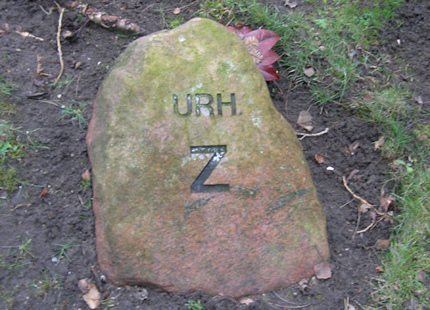
Pet Cemetery, Copenhagen, 2009
— Rainer Maria Rilke
Every design has two lives. One is its historical existence. This is design as encountered in the catalogues and anthologies that justifiably document and date the iconic posters, typefaces, packaging and logos. On the other hand, each and every graphic design signifies a memory. A familiar sign, map or poster can often trigger a set of associations in the viewer, a series of thoughts and feelings that have their own unique trajectory. History is mortal, it resides in a time and place that has since past. Memory remains immune to time. Memories are fleeting, nostalgic, erratic, joyous, enduring and melancholic. They frequently return from the past to deepen our lives in the present.
The fragmentary nature of graphic design, its diverse array of professional, aesthetic, and technological lineages, are more akin to the experience of memory than any traditional historiography. Like memory, graphic design has an unpredictable, chameleon-like quality that pays scant attention to chronological time; nomadic, it drifts across disciplines, amorphous and alive to suggestion and influence. Design, like memory, constantly re-articulates history; it breathes new life into old forms and creations. As Gaston Bachelard once said: "All memory has to be reimagined. For we have in our memories micro-films that can only be read if they are lighted by the bright light of the imagination." Whether it's a 19th-century photo used to promote a 21st-century genealogy website, or an 18th century typeface on an advert for a new car, design accepts the past and present as one.
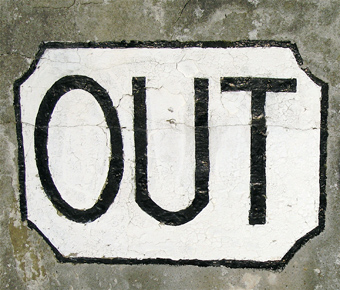
Manor House, Tunbridge Wells, 2008
So far, the story of graphic design has been mostly composed of histories, not memories. Such an approach suffers under the illusion that we can fully comprehend the designed object through the facts and figures of its production. It presupposes a continuity of meaning in the object beyond the life of those writing about it. Such design writing is more akin to a symptom, one that forces a connection, or sees a pattern, where frequently none actually exists. In such moments, when we are drawn to a map, poster, stamp, logo or typeface, the object can blind us to the fact that we have given this design a special meaning, a meaning that we are often unaware of in ourselves. Obviously, we should not deny the historical import of a designer or their work in recording the progression of graphic design. Yet, what frequently emerges from the books documenting these key works and figures is a stark historical record that attempts to close off the gap between the original creation and a present-day re-presentation of it. Such accounts simply disregard how the past is not merely there, but must constantly be re-articulated. It is precisely by acknowledging this gap that we open up a productive space; one that recognizes the blurring of event and feeling, fact and imagination, that are all essential to writing about the ephemeral objects of design. Writing about design is, in this way, similar to that of researching and writing fiction. As the author Margaret Atwood observed in Negotiating with the Dead: A Writer on Writing:
"All writers must go from now to once upon a time, all must go from here
to there; all must descend to where the stories are kept; all must take care
not to be captured and held immobile by the past. And all must commit acts
of larceny, or else reclamation depending how you look at it. The dead may
guard the treasure, but it's useless treasure unless it can be brought back into
the land of the living and allowed to enter time once more — which means to
enter the realm of the audience, the realm of the readers, the realm of change."
Designs are like dreams. Any search for a single interpretation of its signs and symbols will only result in a stilted or highly affected reading. It is more important to ask why a particular work has sought our attention now. Such questions help us become aware of how we continually read meaning retroactively into a design. In fact, the past only makes sense when articulated through the critical ideas and beliefs of our own time. As Walter Benjamin once noted, events (and objects) only become "historical posthumously, as it were, through events that may be separated from it by thousands of years. A historian who takes this as his point of departure stops telling the sequence of events like the beads of a rosary. Instead, he grasps the constellation which his own era has formed with a definite earlier one." While a memory is dependent on earlier experiences it always resides in the present. Because of its ability to move across time, the object of graphic design history is perfectly placed to fully reveal the connecting threads that relate the original design to its re-interpretation.
The French word dérive, or drift, is the most apt way of describing this act. When applied to our sojourns in the city or country, encapsulates this ability to bypass the sanctioned pathways that delineate a terrain. Following your own inclinations or thoughts that arise through unexpected and suggestive encounters can give rise to new ways of reading the landscape and reveal the manner in which everyday life is conditioned and controlled. To dérive, is to remain alert to the unconscious forces at work in the common place. The phrase most often associated with this approach is that of "psychogeography." Coined in 1957, it was used by the Situationist International, a small group of avant-garde artists and intellectuals influenced by Dada, Surrealism and Lettrism who sought out the repressed desires of the urban environment. The group's central proponent, Guy Debord, defined psychogeography as the "study of the precise laws and specific effects of the geographical environment, consciously organized or not, on the emotions and behavior of individuals." To be a psychogeographer is make use of poetry, music, history, rumor, economics or philosophy to detect the reverberations, the long-forgotten undertones, or actively suppressed associations of a street, building or district. By acts of détournment, or turning the sanctioned use of a space on its head, the Situationist's sought to reveal the hollow spectacle of the commodified consumer society and its barren existence that masquerades as an abundance of choice.
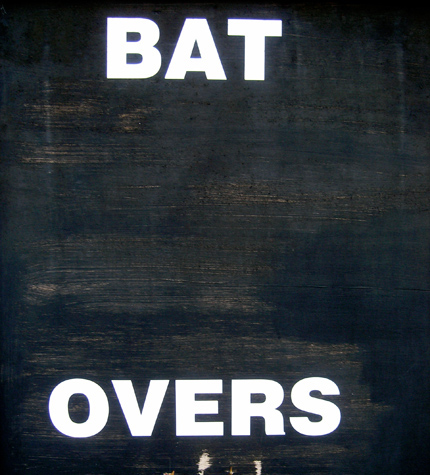
Cricket Ground, London, 2005
While conceding the obvious political anomaly that distinguishes the revolutionary aims and ambitions of the Situationist International from the predilections of most design writing, psychogeography and its ability to multiply and mutate across numerous fields of inquiry makes it fitting model for the analysis of the fractured and diffuse object of graphic design. Whether it's reading maps, following instructions in a cookbook, navigating a complex road system or scanning posters at the local cinema, the many levels at which we engage with graphic design demands a critical approach that is equally eclectic.
Many critics bemoan the fact that graphic design criticism does not have the stature of say film or art history. Yet, while conceding the fact that a great deal of work remains to be done, by looking to the achievements of more established professions are we not missing an opportunity? Surely, rather than pouring new wine into old bottles, shouldn't we attempt to meet the exceptional diversity of design with a critical language that delights in the profusion of graphic objects. For example, why not write about a new newspaper masthead as revealing the economic shifts of a changing society, or approach a postage stamp as if it where an illustration of a philosophical position? To seriously engage with graphic design, an interpretative dexterity is required, one that can imaginatively respond to the currents of time, place and memory that are pertinent in our encounters with the graphic object. If the multilayered reading of the urban and rural landscape is known as psychogeography, I contend that a similar strategy in design could be called psychographics. [1]
Although it is applicable across the wide spectrum of graphic design, one of the areas I believe most receptive to a psychographic approach is that of creating graphic maps. The association of a typeface with a particular city, the unearthing of old shop signs that have long fallen out of use, or the creation of a walk that charts the typographic impact of an 18th century type foundry on its immediate neighborhood — all call for an approach that can drift from memory to imagination, from actuality to fantasy. In this area we could take a lead from the "Memory Map" project established by the writer Marina Warner. Working with Essex University and the Victoria and Albert Museum, Warner has sought to create a reading of place that goes beyond the familiar and predictable. Drawing on writing inspired by paintings, ancient artifacts, local stories and folklore, she has endeavored to create a memory map of Essex. Like the ever attentive psychogeographer, in Warner's words this involves "listening in to other people's ghosts as well as your own." As she continues, it is an approach that:
"grows out of daydreaming, reverie, and the unbidden images that come up in
the mind. This is writing as fugue, as enigma variations, as rapporteur of
what Antonio Damasio has called 'the-movie-in-the-brain', that is, the
phantasmic flow of consciousness...[It] could also have been called after
Proust's madeleine, the subtly flavored biscuit he dipped in tea which, as
if softened, set off a train of memories and meditations. Proust was
revisiting a world he knew in the recent past, whereas Memory Maps
spreads out in rings beyond the familiar and personal past into more
distant time too, and charts, like an old portolan, unexamined coastlines,
land masses, and possible harbors."
When faced with the official histories of a place or region, memory mapping offers the possibility of new stories. "The work of mapping", Warner continues, "involves above all remapping; it beckons us to entertain different, new concepts of the past and work out how they refashion the present." Such pioneers of this form include the writers //www.litencyc.com/php/speople.php?rec=true&UID=4961" title="" target="">Iain Sinclair, W. G. Sebold and Lisa Appignanesi. Delicately unfolding the forgotten stories of time in the vicissitudes of place, their narratives are not nostalgic. Rather, they ingeniously reveal the threads that weave the past and present together. Like all memory maps, they are visions that are uniquely their own.
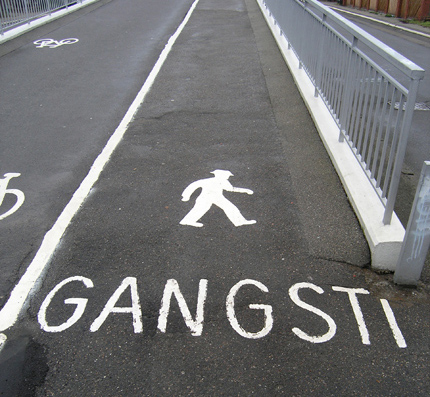
Walkway, Copenhagen, 2009
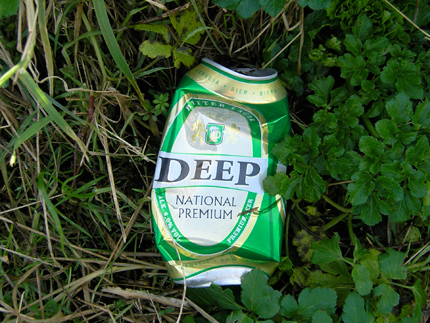
White Cliffs, Dover, 2008
Psychographics can draw on the idea of the memory map by offering a way of reading graphic design that is alert to its evocations and traces of time and place. In recent years, the emergence of the internet has offered a realm for people to explore, for example, the Proustian quality of the faded lettering on a seaside cafe window or the tiled illustrations used to decorate a stairwell in a block of flats. One of the consequences of the internet has been a fragmentation of the newly established histories of graphic design; histories that frequently leave untouched the historians personal relationship to his/her subject. Yet, while the internet offers real opportunities concerning the development of a psychographic approach, the observations on a long forgotten poster, or the vernacular signage at a funfair, rarely rise above a bemused wonderment at its eccentricity or weirdness. Instead, psychographics should be a demanding approach, one that calls upon the critic to employ a diverse range of critical tools to evoke the associations that bellow and swirl around a design. Another common criticism of most internet-based findings is that while the web connects us to an infinite number of people and subjects, the connections remain insubstantial. As Warner has noted, in this digital sphere "we might as well be playing air guitar or air kissing when we make those connections: they are disembodied, ethereal, taking place only through digitized words and pictures on a screen." As with the Memory Map project, the internet can be a viable starting point for psychographic discussions and a meeting of like minds. It must, however, move beyond the flickering light of the monitor towards actual gatherings of people who wish to explore the stories, lives and anecdotes of graphic design.
Although they would not necessarily think of themselves as such, one example of a psychographic community (albeit a temporary and transient one) can be discovered on the typographic tours organized in London since October 2005 by ex-compositor John Voller (in conjunction with Typevents). Beginning at St Bride's Printing Library, these short walks cover an area of London highly responsive to a psychographic reading of design. From the early religious origins of the printing trade associated with the bishops houses of Salisbury Court, to the unexpected connections linking a typographic inscription on a Victorian building with a modern sculpture in an accompanying street, the area has many stories, each different in its own way. While clearly more directed, the walks are not so dissimilar to the dérive's of psychogeography. As Voller himself has discovered, he often discovers new and unknown thoughts arising when looking at lettering. "I find on the walks", Voller remarked, "that when you look at the buildings you start thinking of something else. For instance, I would take the tour to the Museum of London to see an enlarged extract from the journal of the founder of Methodism, John Wesley. The journal is set is Caslon and was printed by the influential printer William Strahan. Walking on, I then came to the house of Dr Samuel Johnson in Gough Square. As is well known, Johnson moved to this house so as to be closer to Strahan, looking to printer to aid him in the printing of his dictionary. So, you begin to see how things are linked and keep coming back." Such an approach is just one of many different ways to interpret the typographic landscape of this area.
In his celebrated essay The Uncanny, Sigmund Freud recounted an occasion when walking around a provincial town in Italy he found himself in a quarter populated by prostitutes. Quickly leaving the area, he walked on until, turning another corner, he found himself back in the same neighborhood. Hastily retreating again, he walked on for many minutes until, for a third time, he found he had returned once again! Clearly, although consciously he sought to leave the quarter, on an unconscious level he desired to return. Freud's discussion of the uncanny highlights his view that what appears to attract us from the outside has in fact been placed there by ourselves (but forgotten or repressed). In a similar way, how many times do we find our attention returning to a particular typeface, poster, illustration or book? As soon as we become aware of this we feel we are seeing it everywhere. In such moments our world becomes covered with the designs we have lived. Psychographics acknowledges how the ephemeral objects of graphic design can continue to reverberate within us long after they have fulfilled their everyday purpose. It acknowledges that any reading of this most transient of visual forms compels us to think and dream at the same time. Each of us has a psychographic story to tell. What's yours?
This article first appeared in Baseline 56, 2009 and is reprinted here with the author's kind permission.
This article first appeared in Baseline 56, 2009 and is reprinted here with the author's kind permission.
Notes
1 I am aware that the term 'psychographics' is commonly associated with an area of marketing engaged in the study of 'demographic variables' i.e. an individual's lifestyle, values, attitudes and interests, etc. However, I feel justified in appropriating this phrase for a more distinguished and critically satisfying purpose.


Comments [4]
09.24.09
03:12
10.02.09
10:43
04.18.10
09:15
Do you see why demographics and psycho graphics are so important now?
You are defining who your customer is and what is important to them
so that when they walk out of your store or buy something from you they get the product and not the commodity.
psychographic profiles
12.27.10
02:10